As noted above, we remain short shares of (and long put options in) Tesla, Inc. (TSLA), which I consider to be the biggest single stock bubble in this whole bubble market—a company so landmine-filled that I think it can implode at any moment regardless of what the broad market does. To reiterate the three core points of our Tesla short position:
1) Tesla has no “moat” of any kind; i.e., nothing meaningfully or sustainably proprietary.
2) Tesla loses a huge (and increasing) amount of money despite relatively light competition but will soon be confronted with massive competition in every aspect of its business.
3) Elon Musk is extremely untrustworthy.
Despite its recent rally TSLA remains 12% off its all-time high and once again appears to be downtrending, and it’s worth noting that although this has been a rough road for us, it’s not a unique one:

I wrote earlier that Tesla may be under an undisclosed Wells Notice, and if that’s the case (and this is completely speculative) it may explain why the company hasn’t been able to take advantage of its $300+ stock price to raise fresh equity. Courtesy of Twitter user @ElonBachman, here’s a terrific representation as to why this is a plausible (but admittedly unproven) theory:
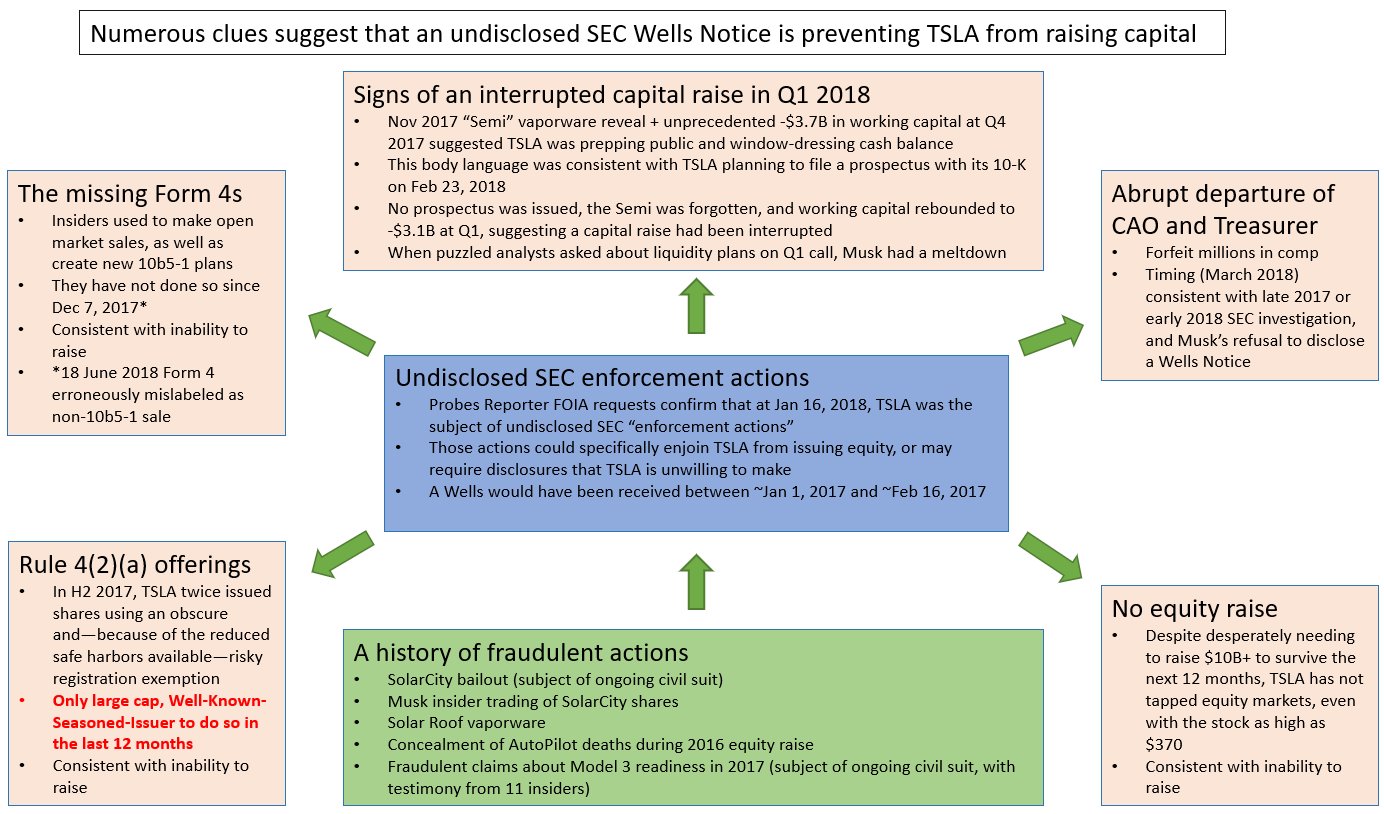
Also “headlining” this month in Tesla news is an astonishing new report from Twitter user @eriz35 (an environmental engineer) pointing out that Tesla’s paint facility only has physical capacity for a total of approximately 5000 cars a week including, presumably, 2000 Models S/X, meaning (if the report is accurate) that Tesla and Elon Musk have been committing blatant securities fraud in claiming to have capacity to build 5-6000 Model 3s a week plus 2000 Models S and X. However, as this story just broke today (June 30th), it’s important to emphasize that we don’t yet have a definitive answer as to its accuracy.
Speaking of paint, early in June came an astounding story about Tesla failing to report multiple fires in its paint shop while simultaneously conducting hugely unsafe practices there (for both employees and customers), followed by another astounding story about the vast amount of scrappage occurring in its manufacturing process accompanied by hugely unsafe practices in how those manufactured parts are labeled and tracked, followed by another astounding story full of well-documented instances of Tesla safety and securities fraud violations. Later in the month Tesla sued the employee whistleblowing source of some of that information, undoubtedly hoping to squelch others in the future. But based on the massive number of recent executive departures (including, in June, the CIO), I strongly suspect that many more whistleblowers will soon appear.
Also in early June came a series of fabulous reviews of the new Jaguar I-Pace electric SUV, which is in European showrooms now and will be available in the U.S. in August. As a reminder, the I-Pace starts at a price $10,000 lower than the Tesla Model X, and that gap will eventually widen to $17,500 as Tesla’s tax credits gradually phase-out beginning late this year or early 2019. Next on tap in luxury EVs are the Audi E-Tron Quattro (to be formally unveiled in September and available in Europe this winter and the U.S. next spring) and the Mercedes EQC (also to be unveiled in September and available next spring), followed by the Porsche Taycan (previously called the Mission E, and available some time in 2019). And all those cars (except the Porsche) will be priced significantly less expensively than the comparable Tesla even before their U.S. buyers enjoy the $7500 tax credit that will soon expire for Tesla. (The Porsche’s base price will be similar to that of the base Tesla Model S and come with the tax credit. Hmmm, Tesla or Porsche… tough choice!)
Next in June came the preliminary NTSB report regarding a fatal Tesla “Autopilot” accident in March, in which it was determined that the car accelerated (where was the Automatic Emergency Braking?) straight into a construction barrier, and that Tesla’s claim that the driver had been warned to keep his hands on the wheel was highly deceptive as the last warning came 15 minutes before the accident. (Also remember that in May Tesla was besieged with multiple tragic accidents—two teenagers were killed in Florida when trapped in a burning Tesla after a high speed crash, as was a German businessman traveling in Switzerland, and a man in California was killed when his Tesla left the road [perhaps due to either Autopilot or a widely-documented but not yet recalled Tesla suspension failure] and deposited him in a pond. And a woman in Utah slammed straight into a parked vehicle while on Autopilot as it accelerated into the impact, similar to what happened in the aforementioned crash in March [although fortunately this lady survived with only a leg fracture], while another Tesla on Autopilot ran into and totaled a police car.) Now where would all those Tesla buyers get that idea that something named “Autopilot” was designed to be used in such a reckless manner?
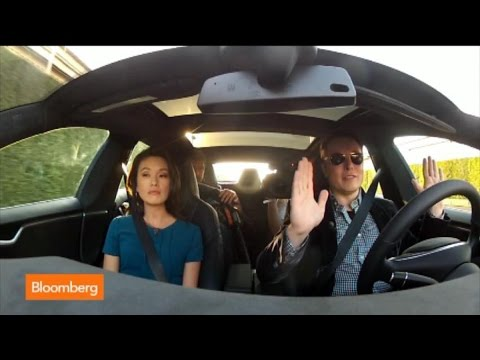
Now watch the short (a bit over a minute) video embedded in this Autopilot story from the BBC and you’ll be shocked at how dangerous this system is! (As an aside, as of now there are at least 40 worldwide Tesla-related deaths, a huge number relative to the number of Teslas on the road and its luxury car peer group.)
In response to the Autopilot demolition derby, in mid-June Tesla remotely limited the hands-free capability of the system to just 15-20 seconds, a significant safety improvement from its previous status and yet hugely disappointing to Tesla owners who were enjoying (at least those still alive) the previous system’s “flexibility.” As Autopilot’s capabilities were oversold by Tesla and Musk from Day 1, it will be interesting to see who now sues for a chunk of his money back, as well as how much lower the uptake of that option will be going forward. (My prediction: much lower.) Remember, that $5000 option is pure margin for Tesla, as every car comes equipped with the hardware regardless of whether or not the buyer pays to activate it. In fact in a blatant attempt to keep his Autopilot fish on the hook, Musk tweeted that in August Tesla would begin implementing full self-driving. Was anybody stupid enough to actually believe that? Well perhaps they were, as the stock closed up over $14/share that day! Here’s a great overview of what—if anything—Tesla will really implement in that regard.
Next in June came an announcement from Electrify America that within the next 12 months it will have built or under development 2000 ultra-fast (150-350 kw, vs. Tesla’s 120 kw) chargers… So much for that Tesla “charging moat”! (See lots of links below showing how many more of these ultra-fast chargers are being built.)
Next in June, just five days after an annual meeting during which “everything was great,” Musk announced layoffs of 9% of Tesla’s work force, which he essentially said was necessary to avoid bankruptcy. (I suspect it won’t work.) Among those fired were reportedly a significant number of engineers—very impressive for an automobile manufacturer with a massive vaporware pipeline and serious aging & reliability problems with its existing products. On the day of that layoff announcement and the day after, Musk bought $25 million of Tesla stock, much (and possibly all) of which was done in the illiquid pre-market in order to jam up the price up as much as possible. The effect of this was to cause algorithmic computers to bid the stock up from there, further squeezing shorts and thereby forcing the stock up still higher. Clearly the sole purpose of Musk’s timing (after all, his buy was insignificant relative to his holdings) was to punish short sellers, possibly figuring that if he’s going down, he’ll take as many shorts down with him as he can. Sorry Elon, but we’ll still be here, and we won’t be visiting you where you’re going.
Next in June came an analysis by Gordon Johnson, an analyst at Vertical Group, estimating that the Model 3 cancellation rate is as high as 66%. No wonder Tesla—which never fails to report a favorable data point (even if it has to fabricate it)—refuses to update the current net Model 3 reservation number (and by net I mean net of requested refunds too, as numerous Twitter posts indicate that the cash-strapped company is delaying those requests for weeks or even months). And watch those reservations really vanish when Tesla’s $7500 tax credits expire later this year while over 100 competing new EV models entering the market over the next few years will still enjoy them, and potential buyers realize that the $35,000 Model 3 will never appear in any significant quantity. In fact, in May Musk admitted that a $35,000 Model 3 is a long way off because “building one now would cause Tesla to lose money and die.” I have news for you, Elon: whether you build them or not, Tesla is going to “lose money and die.”
Next in June—courtesy of Twitter user @TeslaCharts—came the most concise summary yet of how Elon Musk committed securities fraud by using Tesla to bail out his (and his family’s) failing stakes in SolarCity. Zero Hedge included the entire thread in this follow-up story about SolarCity’s latest retrenchment, which will undoubtedly help fuel the fraud case currently working its way through a Delaware court, as will this later story describing how Tesla sales people have no idea when the solar tiles or PowerWalls used to justify that merger will ever be available. (Remember that when Musk was promoting that merger he used fake solar tiles on a fake house at a movie studio… How appropriate!)
Next in June, Elon Musk finally accomplished full convergence with P.T. Barnum, his circus-owning spiritual ancestor (except Barnum’s circuses made money while Musk’s just incinerates it). Let’s start with this Elon Musk Twitter-quote as headlined (amazingly!) not by The Onion but by Ars Technica in this article:

Yes, that’s right: unable to build 5000 Model 3s a week in factory for which Musk said capacity was well over 10,000, Tesla has resorted to pitching a tent in its parking lot and setting up some sort of half-assed partial assembly line. And oh, he introduced it in one of the most blatantly fraudulent manners I’ve ever seen, using a prop (or perhaps photoshopped) car obviously built elsewhere while claiming it was built there. Why do I say “obviously”? Because on the same day he tweeted this…
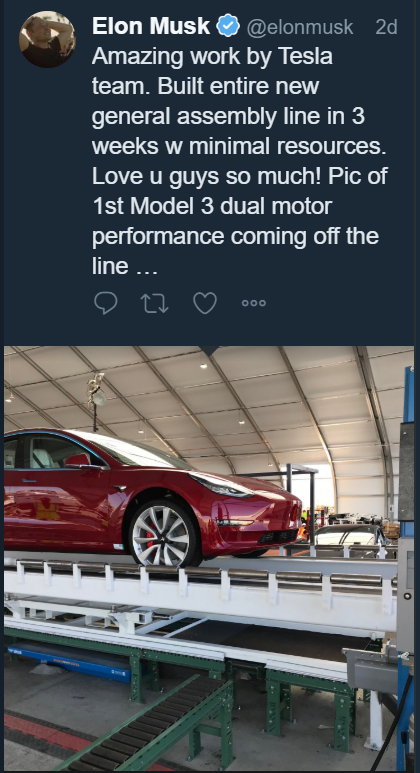
…Twitter user @skabooshka had staked the place out with a telephoto lens and snapped this, including an appropriately headlined newspaper to prove it was taken that same day:
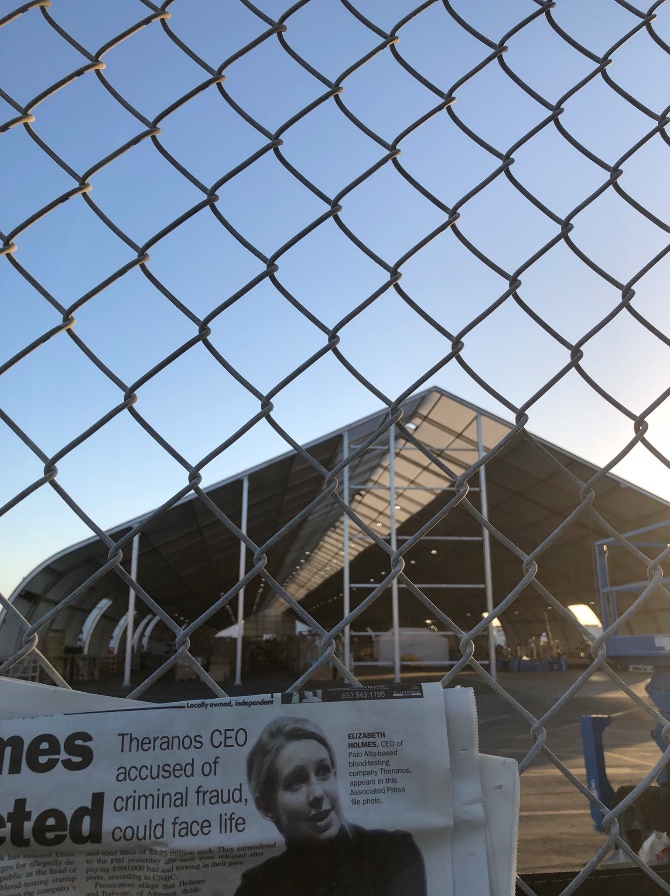
Then a few days later, Twitter user @iSpyTSLA posted a number of videos (linked in this Zero Hedge article) demonstrating that this Tesla “assembly line tent show” makes a 1970s Yugo factory look state-of-the-art, while almost concurrently Musk bizarrely tried to blame his production problems on “an internal saboteur.” Tesla then proceeded to cover the fence through which those images were taken and strategically parked semi-trailers to further block the view. But that’s okay, because a week or so later @skabooshka sent up a drone to once again prove Musk was lying! Yes, I know… If you tried to write a “corporate thriller” with a plot like this, your publisher would laugh you out of his office!
Also in June Business Insider published a scoop featuring leaked internal Tesla documents indicating that the month-to-date Model 3 production rate was averaging just 2200 cars a week, far below the 3500 a week Elon Musk deceptively implied at the June annual meeting. Yes, more securities fraud.
Also in June Bernstein Research published a note finally pointing out something we’ve been talking about for the better part of a year: Tesla is committing accounting fraud by artificially inflating its automotive gross margin by under-reserving for warranty repairs, then putting extra repair costs on the “Services and Other” line (which has a hugely negative gross margin).
Late in June Tesla announced that all remaining North American Model 3 reservationists can now configure their cars. Although this theoretically could be indicative of the weak Model 3 conversion rate noted above, it could also just be a desperate cash grab for the $2500 additional deposits that must accompany those configurations. However, this announcement came simultaneously with price cuts for the all-wheel-drive and “performance” versions of the Model 3, which *is* indicative of a demand problem.
Meanwhile, Tesla is now in such bad financial shape that all sorts of liens are piling up against it in its home county of Alameda. Here’s a snapshot I happened to take on June 21st of just those filed since March:
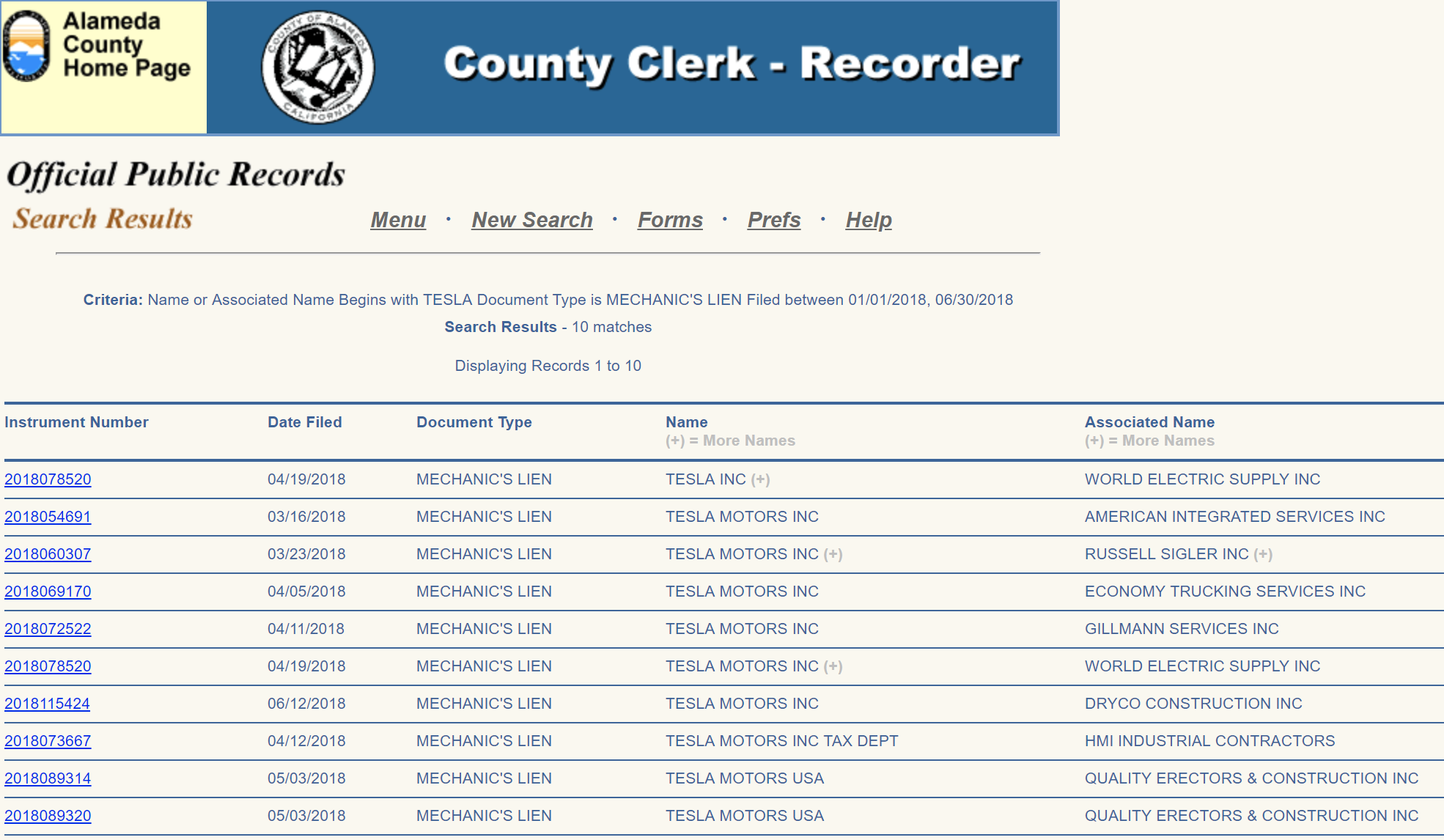
And on top of that, Tesla now has state and federal tax liens against it.
Remember that in May Tesla released a disastrous Q1 earnings report, with a record GAAP loss of $710 million ($760 million excluding the sale of ZEV credits– an average of over $25,000 per car sold!), negative free cash flow of $1.1 billion, Model S&X combined deliveries down a double-digit percentage both sequentially and year-over-year (even before the arrival of all the luxury EV competition mentioned earlier in this letter), and Model 3 production falling far short of (already drastically reduced) previous guidance. Here’s a terrific series of charts from Twitter user @TeslaCharts clearly explaining just how horrible the financial trends for this company are; in fact Tesla’s situation is so dire that it’s slashing capex (and thus killing the growth story) by apparently putting development of its much-hyped (but economically unviable) semi-truck on hold, as well as delaying its “Model Y” crossover. In fact even Tesla battery supplier Panasonic now has serious doubts about the viability of the company. And for those who continue to insist that as Tesla grows revenue, profits will “scale” proportionately… How’s this for “scale”?
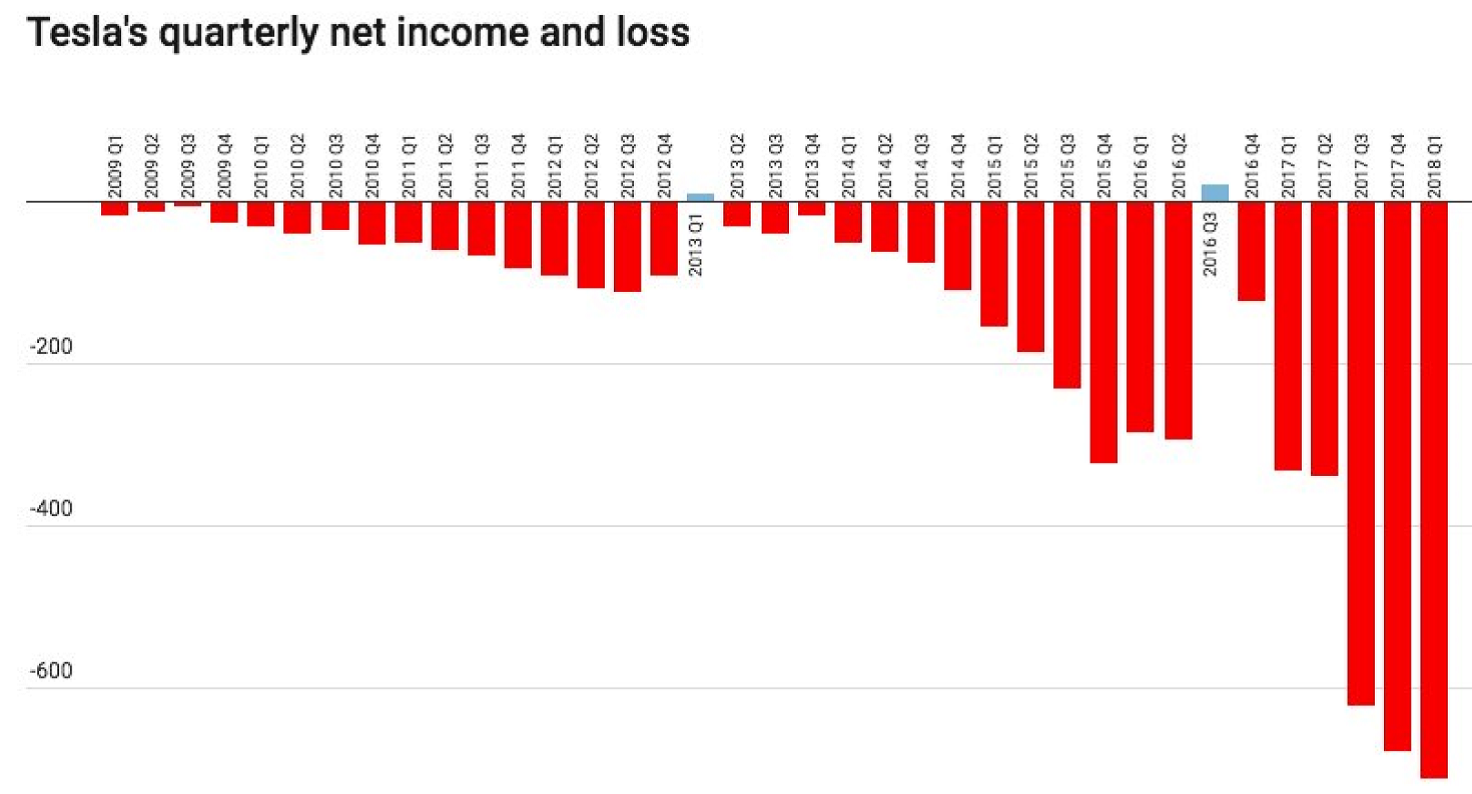
Following the release of that atrocious earnings report, Tesla hosted what may be the most hilarious conference call in American corporate history. (I know I’ve said that about previous calls but let’s face it: Musk is a conference call superstar who somehow manages to “top” his previous performance with each new one!) Here are just a few of the “highlights” as he tried to duck, shuck and jive his way out of having to explain away Tesla’s looming destiny with bankruptcy, which is where its > $30 billion in combined long-term debt and battery purchase & other obligations—accompanied by its negative cash flow and massive encroaching competition—will eventually place it.
And no, the savior of Tesla won’t be the Model 3. Regardless of whether Tesla hits the 5000 per week production goal it has managed to make as the media’s primary focus, the car will be a financial disaster. Additionally, extensive forum posts and reviews indicate that over time the Model 3 is revealing itself to be a complete lemon, while even green car-loving Consumer Reports rated it just a 77 on a scale of 100, tied (among electric cars) with the $14,000 cheaper Chevrolet Bolt and $25,000 cheaper Toyota Prius. (Unlike Edmunds, CR has yet to rate the Model 3’s reliability.) And remember, almost nothing can be done in the Model 3 without a multi-step process on the touchscreen—not even changing the windshield-wiper speed, adjusting the air vents or opening the glovebox. Thus, operating a Tesla Model 3 may potentially be as dangerous as texting while driving.
Meanwhile, Tesla is increasingly besieged by a wide variety of lawsuits for securities fraud, labor discrimination, worker safety, union-busting, sudden acceleration, lemon law violations and, undoubtedly, many others of which I’m not yet aware.
So here is Tesla’s competition in cars (note: these links are continually updated)…
Jaguar Electric I‑Pace SUV Available Summer 2018
2019 Jaguar XJ to be reborn as high-tech electric flagship
Jaguar Land Rover will boost spending to $18 billion to fund EVs
2019 Audi E-Tron To Charge Faster Than Tesla Supercharger Network
2020 Porsche Taycan (available 2019): Here’s What We Know
Porsche Cross Turismo to be its second EV
Mercedes 2019 EQC To Be Unveiled This September
Mercedes Plans Electric S-Class to Challenge Tesla’s Flagship
Mercedes Wheels Out Electric Car Roadmap, Car And Battery Factories Everywhere
2019 Hyundai Kona Electric gets 250-mile range rating in the U.S.
14 new EV models by Hyundai-Kia by 2025
Chevrolet Bolt Offers 238 Miles On A Single Charge For $37,495
GM to introduce 3 more electric cars before 2020, battery cells at <$100/kWh
2018 Nissan Leaf: 150 miles for $30,875, 200+ mile model by late 2018
Nissan Leaf-based SUV coming in 2020
Volvo Electric hatchback due in 2019
Volvo To Start Selling Electric Trucks In 2019, Some Will Hit The Road This Year
VW will build EVs in 16 factories in zero emissions push
Volkswagen I.D. Crozz 311-Mile Electric CUV For $30,000-ish Before Incentives
VW’s All-Electric I.D. Vizzion Coming With 400 Miles of Range
BMW will export iX3 electric SUV to Europe, U.S. from China
BMW to have 25 electrified models by 2025
Ford plans $11 billion investment, 40 electric vehicles by 2022
Toyota, Mazda, Denso create company to roll out electric cars beginning 2019
Toyota to market over 10 battery EV models in early 2020s
Infiniti will go mostly electric by 2021
PSA will launch full-electric Peugeot 208 and DS 3 Crossback in 2019
ALL-ELECTRIC MINI COOPER COMING IN 2019
Smart Will Electrify Its Entire Line-up By 2020
SEAT’s first electric car is due in 2020
Opel will launch full electric Corsa in 2020
2019 Skoda e-Citigo confirmed as brand’s first all-electric model
MG E-Motion confirms new EV sports car on the way by 2020
Aston Martin to create all-electric car brand
Fiat Chrysler bets on electrification for Alfa, Jeep and Maserati
Maserati to take on ‘Porsche and Tesla’ with Alfieri, new SUV and four EVs
Renault investing > €1B for development and production of EVs in France
Rolls-Royce is preparing electric Phantom for 2022
Citroen preparing EV push with 80 per cent electrified range by 2023
Honda will offer full-EV or hybrid tech on every European model by 2025
All-electric Bentley four-door coupe to use EV tech from Porsche Mission E
Subaru to introduce all-electric vehicles by 2021
Ssangyong e-SIV concept previews 2020 EV
Dyson plans three-car EV range
235mph Lucid Air due in 2019 as electric BMW 7 Series rival
Borgward BXi7 Electric SUV Flies Under The Radar
Detroit Electric promises 3 cars in 3 years
SF Motors reveals two electric SUVs for 2019 with 300 miles of range
Two new electric cars from Mahindra in India by 2019; Global Tesla rival e-car soon
Saab asset owner NEVS plans electric car production
EVelozcity Raises $1 billion For EV Startup
Flush with new cash, electric-car company Faraday Future hopes for a fresh start
And in China…
Daimler & BYD launch new DENZA electric vehicle for the Chinese market
BAIC and Daimler to Build $1.9 Billion China Plant
Volkswagen makes €15bn bet on electric cars in China
Volkswagen Group China’s mega-factory in Foshan will strengthen e-mobility strategy in China
Audi to launch 7 new energy vehicle models in China by 2020
GM China raises new-energy vehicle target to 20 models through 2023
Nissan & Dongfeng to invest $9.5 billion in China to boost electric vehicles
Toyota to Introduce 10 New Electrified Vehicles in China by 2020
Infiniti bringing EVs to China’s luxury car market
BMW will develop and produce electric Mini in China
Ford ramps up electric vehicle push in China
China’s BYD tops global electric-car production for third year in a row
SAIC to spend $2.2 billion on EVs, connectivity, aftersales services
Honda debuts Everus electric car for China
Changan building large scale NEV factory
Mazda and Changan Auto join hands on electric vehicles
WM Motors/Weltmeister EX5 Electric SUV Launched On The Chinese Car Market
NIOS ES8 Electric Crossover debuts with half the Tesla Model X’s price tag
Geely invests $5 billion into new electric car factory in China
Chery Breaks Ground on $240M EV Factory in China
Chery’s second EV plant open in Dezhou
Leapmotor’s electric car to hit the market in 2018
Alibaba-backed Xiaopeng Motors to raise US$2.7 billion this year
GAC Trumpchi to launch range-extended EVs
Guangzhou Auto To Launch Four New Electric Cars By 2020
Chinese carmaker Byton unveils its fully autonomous rival to Tesla’s electric sedans
Chinese-backed electric car start-up Byton woos CES with model 40% cheaper than a Tesla
Great Wall Starts New EV Brand (ORA) In China
Singulato iS6 Electric SUV Debuts With 249-Mile Range
Singulato, BAIC partner to promote smart new energy vehicles
FAW (Hongqi) to roll out 15 electric models by 2025
JAC’s Electric Car Has A Range Of 500 Kilometers
ICONIQ to build electric cars in Zhaoqing with total investment of RMB 16 billion
Quianu Motor aims to grab share of US electric vehicle market
All-electric NEVS 9-3 sedans (nee Saab) being built in China
Youxia Motors Secures USD794 Million to Push Release of New Connected Cars
Wanxiang Gets China Electric Vehicle Permit to Make Karma Cars
Qoros Auto’s new owner plans to be an EV power
JMC (Jianling Motor Corp.) Starts New EV Brand In China
Thunder Power electric cars at the Frankfurt motor show
Here’s Tesla’s competition in autonomous driving…
Tesla Ranks Last for Automated Driving
A Tesla self-driving blind spot that few are focusing on
Waymo is first to put fully self-driving cars on US roads without a safety driver
Jaguar and Waymo announce an electric, fully autonomous car
Waymo Expands Chrysler Self-Driving Fleet 100-Fold to 62,000
Uber, Waymo in talks about self-driving partnership
Lyft and Waymo Reach Deal to Collaborate on Self-Driving Cars
Cadillac Super Cruise™ Sets the Standard for Hands-Free Highway Driving
GM ride-hailing fleet would ditch steering wheel, pedals in 2019
SoftBank Vision Fund to Invest $2.25 Billion in GM Cruise
An Overview of Audi Piloted Driving
Updated 2017 Mercedes-Benz S-Class – first ride with autonomous technology
NVIDIA and Toyota Collaborate to Accelerate Market Introduction of Autonomous Cars
Volkswagen and NVIDIA to Infuse AI into Future Vehicle Lineup
NVIDIA Partners with Bosch for System Based on Next-Generation DRIVE PX Xavier Platform
Continental & NVIDIA Partner to Enable Production of Artificial Intelligence Self-Driving Cars
Bosch and Daimler join forces to market fully automated, driverless taxis by 2020
Intel’s Mobileye will have 2 million cars (VW, BMW & Nissan) on roads building HD maps in 2018
Volkswagen Group and Aurora Innovation Announce Strategic Collaboration On Self-Driving Cars
Toyota, Intel and others form big data group for autonomous tech
Toyota Adds $2.8 Billion to Software Push for Self-Driving Cars
Nissan’s Robo-Taxis Will Hit the Road in March
Nissan and Mobileye to generate, share, and utilize vision data for crowdsourced mapping
Magna joins the BMW Group, Intel and Mobileye platform as an Integrator for AVs
Intel collaborates with Waymo on self-driving compute design
Fiat Chrysler to Join BMW, Intel and Mobileye in Developing Autonomous Driving Platform
Ford-Backed Driverless-Car Startup Argo AI Lures Talent
Lyft, Aptiv (formerly Delphi) partner on driverless ride-hailing at 2018 CES in Vegas
Lyft, Magna in Deal to Develop Hardware, Software for Self-Driving Cars
Hyundai, Aurora to release autonomous cars by 2021
Deutsche Post to Deploy Test Fleet Of Fully Autonomous Delivery Trucks This Year
Byton cooperating with Aurora on autonomous vehicles
Magna’s new MAX4 self-driving platform offers autonomy up to Level 4
Bosch Creates a Map That Uses Radar Signals for Automated Driving
Honda Targeting Level 3 Automated Driving By 2020, Level 4 by 2025
Groupe PSA’s safe and intuitive autonomous car tested by the general public
Baidu unveils autonomous driving platform backed by 90 global partners
Baidu plans to mass produce Level 4 self-driving cars with BAIC by 2021
BlackBerry and Baidu Partnering to Accelerate Connected and Autonomous Vehicle Technology
Tencent, Changan Auto Announce Autonomous-Vehicle Joint Venture
JD.com Delivers on Self-Driving Electric Trucks
NAVYA Unveils First Fully Autonomous Taxi
Fujitsu and HERE to partner on advanced mobility services and autonomous driving
Lucid Chooses Mobileye as Partner for Autonomous Vehicle Technology
First Look Inside Zoox’s Autonomous Taxi
Apple Is Focusing on Making an Autonomous Car System
Samsung, Harman gear up for self-driving automobiles
Mitsubishi Electric Develops Automated Mapping For Autonomous Driving
Hitachi demonstrates vehicle with 11-function autonomous driving ECU
DENSO and NEC Collaborate on Automated Driving and Manufacturing
Nuro’s Robot Delivery Vans Are Arriving Before Self-Driving Cars
Here’s Tesla’s competition in car batteries…
LG Chem targets electric car battery sales of $6.3 billion in 2020
Samsung SDI Unveils Innovative Battery Products at 2018 Detroit Motor Show
SK Innovation to produce EV batteries with 500 km range in 2018
New Toshiba EV Battery Allows 320km Charge in 6 Minutes
Daimler opens its sixth battery factory
Panasonic Opens New Automotive Lithium-Ion Battery Factory in Dalian, China
Panasonic forms battery partnership with Toyota
CATL’s Chinese battery factory will be bigger than Tesla’s Gigafactory
CATL to set up battery cell manufacturing in Germany
BYD to quadruple car battery output with lithium site plants
GM inaugurates battery assembly plant in Shanghai
Honda Partners on General Motors’ Next Gen Battery Development
Energy Absolute Plots Asian Project Rivaling Musk’s Gigafactory
European Battery Alliance (EBA) is taking shape
Chinese Battery Maker to Open Factory Next to Swedish EV Plant
Sokon aims to be global provider of battery, electric motor, electric control systems
BMW Group invests 200 million euros in Battery Cell Competence Centre
BMW Brilliance Automotive opens battery factory in Shenyang
BMW announces partnership with solid-state battery company
Toyota promises auto battery ‘game-changer’
VW increase stake in solid-state batteries with $100M investment
Hyundai Motor developing solid-state EV batteries
Continental eyes investment in solid-state batteries
Wanxiang is playing to win, even if it takes generations
UK provides millions to help build more electric vehicle batteries
Rimac is going to mass produce batteries and electric motors for OEMs
Elon Musk Has A New Battery Rival (Romeo Power) Packed With His Ex-Employees
Bracing for EV shift, NGK Spark Plug ignites all solid-state battery quest
ProLogium Technology Will Produce First Next Generation Lithium Ceramic Battery For EVs
Here’s Tesla’s competition in storage batteries…
And here’s Tesla’s competition in charging networks…
EVgo Installing First 350 kW Ultra Fast Public Charging Station In The US
Tritium’s First 350-kW DC Fast Chargers Coming To U.S.
Porsche plans network of 500 fast chargers for U.S.
BMW, Daimler, Ford, VW, Audi & Porsche form IONITY European 350kw Charging Network
E.ON to have 10,000 150KW TO 350KW EV charging points across Europe by 2020
Europe’s Allego “Ultra E” ultra-fast charging network now operational
Allego & Fortum Launch MEGA-E High Power Charging network for Europe’s Metropolitan areas
Chargepoint Europe Gets $82 million in new funding from Daimler
ChargePoint – InstaVolt partnership; more than 200 UK rapid charge systems
UK’s Podpoint installing 150kW EV rapid chargers this year; 350kW by 2020
UK National Grid plans 350kW EV charge point network
ChargePoint Express Plus Debuts: Offers Industry High 400 kW DC Fast Charging
Fastned building 150kw-350kw chargers in Europe
ABB powers e-mobility with launch of first 150-350 kW high power charger
Shell buys European electric vehicle charging pioneer NewMotion
BP buys UK’s largest car charging firm Chargemaster
Total planning EV charging points at its French stations
Yet despite all that deep-pocketed competition, perhaps you want to buy shares of Tesla because you believe in its management team. Really???
Elon Musk, June 2009: “Tesla will cross over into profitability next month”
Tesla SEC Correspondence Shows A Pattern Of Inaccurate, Incomplete & Misleading Disclosures
Tesla: Check Your Full Self-Driving Snake Oil Expiration Date
As Musk Hyped and Happy-Talked Investors, Tesla Kept Quiet About a Year-Long SEC Probe
The Truth Is Catching Up With Tesla
With Misleading Messages And Customer NDAs, Tesla Performs Stealth Recall
Who You Gonna Believe? Elon Musk’s Words Or Your Own Lying Eyes?
How Tesla and Elon Musk Exaggerated Safety Claims About Autopilot and Cars
When Is Enough Enough With Elon Musk?
Musk Talked Merger With SolarCity CEO Before Tesla Stock Sale
Tesla Continues To Mislead Consumers
Tesla Misses The Point With Fortune Autopilot Story
Tesla Timeline Shows Musk’s Morality Is Highly Convenient
Tesla Scares Customers With Worthless NDAs, The Daily Kanban Talks To Lawyers
Tesla: Contrary To The Official Story, Elon Musk Is Selling To Keep Cash
Tesla: O, What A Tangled Web We Weave When First We Practice To Deceive
I Put 20 Refundable Deposits On The Tesla Model 3
Tesla: A Failure To Communicate
Elon Musk Appears To Have Misled Investors On Tesla’s Most Recent Conference Call
Understanding Tesla’s Potemkin Swap Station
Tesla’s Amazing Powerwall Reservations
So in summary, Tesla is losing a massive amount of money even before it faces a huge onslaught of competition (and things will only get worse once it does), while its market cap tops those of both Ford and GM despite a $2.8 billion+ annualized net loss selling a bit over 150,000 cars while Ford and GM make billions of dollars selling 6.6 million and 9 million cars respectively. Thus this cash-burning Musk vanity project is worth vastly less than its nearly $70 billion fully-diluted enterprise value and—thanks to its roughly $31 billion in debt and purchase obligations—may eventually be worth “zero.”
